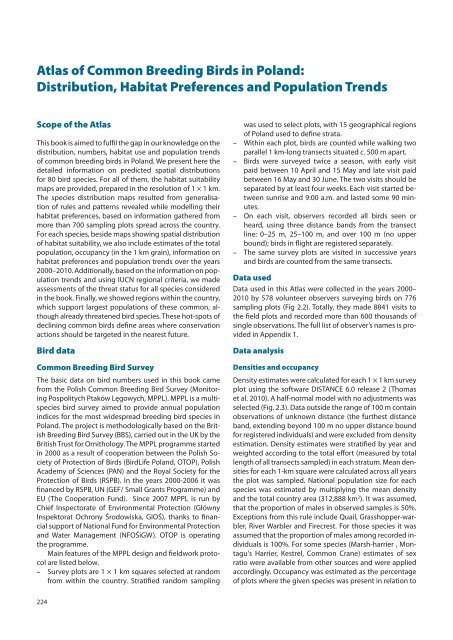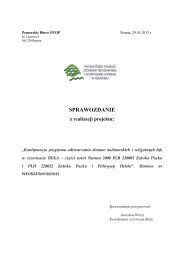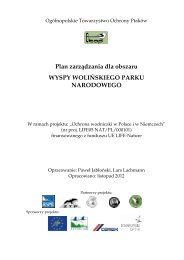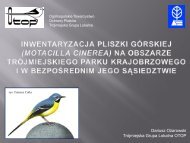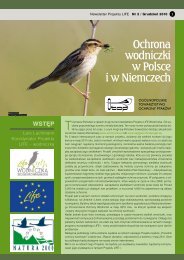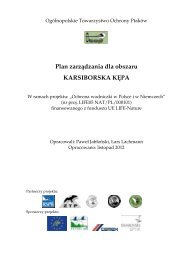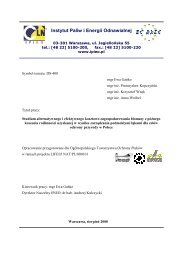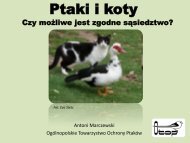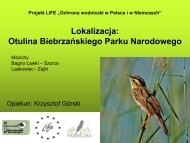Atlas pospolitych ptaków lęgowych Polski
Atlas pospolitych ptaków lÄgowych Polski
Atlas pospolitych ptaków lÄgowych Polski
- No tags were found...
Create successful ePaper yourself
Turn your PDF publications into a flip-book with our unique Google optimized e-Paper software.
<strong>Atlas</strong> of Common Breeding Birds in Poland:<br />
Distribution, Habitat Preferences and Population Trends<br />
Scope of the <strong>Atlas</strong><br />
This book is aimed to fulfil the gap in our knowledge on the<br />
distribution, numbers, habitat use and population trends<br />
of common breeding birds in Poland. We present here the<br />
detailed information on predicted spatial distributions<br />
for 80 bird species. For all of them, the habitat suitability<br />
maps are provided, prepared in the resolution of 1 × 1 km.<br />
The species distribution maps resulted from generalisation<br />
of rules and patterns revealed while modelling their<br />
habitat preferences, based on information gathered from<br />
more than 700 sampling plots spread across the country.<br />
For each species, beside maps showing spatial distribution<br />
of habitat suitability, we also include estimates of the total<br />
population, occupancy (in the 1 km grain), information on<br />
habitat preferences and population trends over the years<br />
2000–2010. Additionally, based on the information on population<br />
trends and using IUCN regional criteria, we made<br />
assessments of the threat status for all species considered<br />
in the book. Finally, we showed regions within the country,<br />
which support largest populations of these common, although<br />
already threatened bird species. These hot-spots of<br />
declining common birds define areas where conservation<br />
actions should be targeted in the nearest future.<br />
Bird data<br />
Common Breeding Bird Survey<br />
The basic data on bird numbers used in this book came<br />
from the Polish Common Breeding Bird Survey (Monitoring<br />
Pospolitych Ptaków Lęgowych, MPPL). MPPL is a multispecies<br />
bird survey aimed to provide annual population<br />
indices for the most widespread breeding bird species in<br />
Poland. The project is methodologically based on the British<br />
Breeding Bird Survey (BBS), carried out in the UK by the<br />
British Trust for Ornithology. The MPPL programme started<br />
in 2000 as a result of cooperation between the Polish Society<br />
of Protection of Birds (BirdLife Poland, OTOP), Polish<br />
Academy of Sciences (PAN) and the Royal Society for the<br />
Protection of Birds (RSPB). In the years 2000-2006 it was<br />
financed by RSPB, UN (GEF/ Small Grants Programme) and<br />
EU (The Cooperation Fund). Since 2007 MPPL is run by<br />
Chief Inspectorate of Environmental Protection (Główny<br />
Inspektorat Ochrony Środowiska, GIOŚ), thanks to financial<br />
support of National Fund for Environmental Protection<br />
and Water Management (NFOŚiGW). OTOP is operating<br />
the programme.<br />
Main features of the MPPL design and fieldwork protocol<br />
are listed below.<br />
–– Survey plots are 1 × 1 km squares selected at random<br />
from within the country. Stratified random sampling<br />
––<br />
––<br />
––<br />
––<br />
was used to select plots, with 15 geographical regions<br />
of Poland used to define strata.<br />
Within each plot, birds are counted while walking two<br />
parallel 1 km-long transects situated c. 500 m apart.<br />
Birds were surveyed twice a season, with early visit<br />
paid between 10 April and 15 May and late visit paid<br />
between 16 May and 30 June. The two visits should be<br />
separated by at least four weeks. Each visit started between<br />
sunrise and 9:00 a.m. and lasted some 90 minutes.<br />
On each visit, observers recorded all birds seen or<br />
heard, using three distance bands from the transect<br />
line: 0–25 m, 25–100 m, and over 100 m (no upper<br />
bound); birds in flight are registered separately.<br />
The same survey plots are visited in successive years<br />
and birds are counted from the same transects.<br />
Data used<br />
Data used in this <strong>Atlas</strong> were collected in the years 2000–<br />
2010 by 578 volunteer observers surveying birds on 776<br />
sampling plots (Fig 2.2). Totally, they made 8841 visits to<br />
the field plots and recorded more than 600 thousands of<br />
single observations. The full list of observer’s names is provided<br />
in Appendix 1.<br />
Data analysis<br />
Densities and occupancy<br />
Density estimates were calculated for each 1 × 1 km survey<br />
plot using the software DISTANCE 6.0 release 2 (Thomas<br />
et al. 2010). A half-normal model with no adjustments was<br />
selected (Fig. 2.3). Data outside the range of 100 m contain<br />
observations of unknown distance (the furthest distance<br />
band, extending beyond 100 m no upper distance bound<br />
for registered individuals) and were excluded from density<br />
estimation. Density estimates were stratified by year and<br />
weighted according to the total effort (measured by total<br />
length of all transects sampled) in each stratum. Mean densities<br />
for each 1-km square were calculated across all years<br />
the plot was sampled. National population size for each<br />
species was estimated by multiplying the mean density<br />
and the total country area (312,888 km 2 ). It was assumed,<br />
that the proportion of males in observed samples is 50%.<br />
Exceptions from this rule include Quail, Grasshopper-warbler,<br />
River Warbler and Firecrest. For those species it was<br />
assumed that the proportion of males among recorded individuals<br />
is 100%. For some species (Marsh-harrier , Montagu's<br />
Harrier, Kestrel, Common Crane) estimates of sex<br />
ratio were available from other sources and were applied<br />
accordingly. Occupancy was estimated as the percentage<br />
of plots where the given species was present in relation to<br />
224


